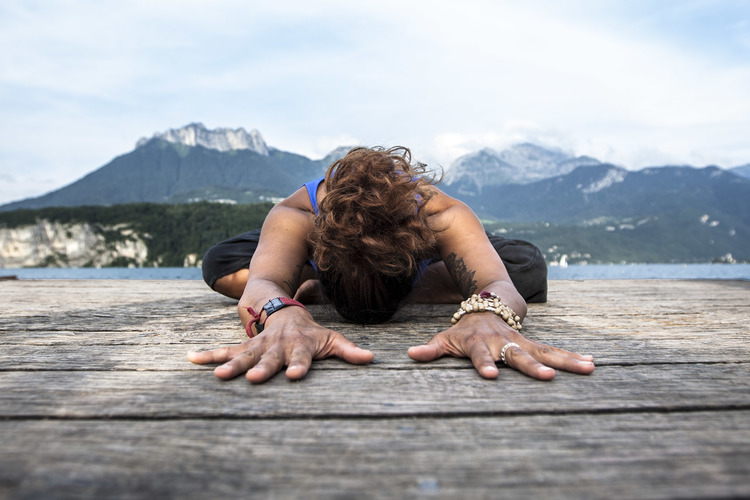
“Yoga teaches us to cure what need not be endured and endure what cannot be cured” ~ B.K.S. Iyengar
November is Crohn’s and Colitis Awareness month in Canada!
As a yoga student and teacher who also happens to have Crohn’s Disease, I thought I could do my part to spread awareness by sharing my insights on practicing yoga while living with IBD (Irritable Bowel Disease, the umbrella category that both Crohn’s Disease and Ulcerative Colitis fall under).
In case you clicked on this article out of curiosity but have no idea what these illnesses are: Crohn’s Disease and Ulcerative Colitis (UC) are both chronic autoimmune conditions in which the immune system overacts and attacks its host. Crohn’s can affect a person anywhere along the digestive tract, from mouth to anus; whereas Colitis is contained to the colon and rectum. Crohn’s most commonly impacts the small intestine or colon where it causes inflammation and deep ulcers through both layers of the intestinal lining. The main symptoms of Crohn’s Disease are abdominal pain, diarrhea, fatigue, and weight loss. Colitis differs slightly in appearance because it causes inflammation and ulcers that penetrate the first layer of the intestinal lining, typically resulting in bloody diarrhea, fatigue, and pain. Symptoms and severity vary greatly from person to person so there is no ‘one shared experience’ that all people with IBD will have, but most people will experience periods of remission and periods of flare-ups throughout their lifetime.
I was diagnosed with Crohn’s six years ago, when I was 19 years old. The last six years has been a huge learning curve with lots of ups and downs, but I am very happy to say that in the last year I have been in remission and feeling great!
My relationship with yoga has helped me to live with chronic illness because it has taught me tools of self-soothing/self-comfort and how to manage stress (a trigger of flare-ups for me); these have been incredible gifts. My yoga practice has been something that I can lean into when I need the extra support and, like an old friend who is always around but who truly shows up for you when you need it most, it has played a central role in how I cope.
Here are a few things that you may want to try or avoid if you suffer from IBD:
Pranayamas (yogic breathing techniques):
To try: Dirgha or Three-Part Breath. This cooling breath helps trigger the relaxation response of the parasympathetic nervous system, which will be beneficial if you find that your disease is highly sensitive to stress. It also provides a gentle massage for the abdominal organs.
Instructions for Dirgha: Dirgha is long, slow breath through the nostrils that aims to use the full capacity of the lungs. Place your hand over your belly and breath into the belly and watch it fill up and rise like a balloon with each inhale and with each exhale feel watch it empty as the belly button draws in towards the spine. Now draw your hands up to your ribcage and take the breath into the bottom of your ribs, feeling them splay out to the side like the gills of a fish with each inhale, and then with each exhale they draw in towards your centre. Finally, place the tips of your fingers just under your collar bones and breath into the top of the lungs—watching the chest rise and fall with each breath. Dirgha is practiced by breathing into the belly, then the ribs, then the collarbones and exhaling from the collar bone, the ribs, then the belly—as though you are filling a glass from the bottom up and emptying from the top down.
To Avoid: Kapalabahti or Skull Polishing Breath. This breath is very heating and can aggravate digestive issues.
Asanas (yoga poses):
If you are dealing with constipation, try to integrate a few of the following postures into your practice: Wind-Relieving pose, Goddess pose, Yogic Squat, Warrior I, Standing Wide Angle or Bound Angle pose. All of these poses promote a downward flow of energy and can assist your digestive system. On the flip side, if you are in a flare up and experiencing diarrhea, you will want to proceed with caution in these poses. Other poses to avoid during a flare up are more intuitive, like belly-down postures (Bow, Cobra or Boat). If you want an alternative to engage the back, try a gentle standing backbend, Camel pose or Upward Facing Boat. Personally, I also find Bridge and Full Wheel poses to be uncomfortable if I am feeling unwell so I opt for a low Bridge or I pulse slowly in and out of my Bridge pose.
During a flare up, your body will also tell you to slow down your forward folds and to twist gently. You can feel your own boundaries and notice what works for you.
Meditation and Yoga Nidra
Yoga Nidra is translated as ‘Yogic Sleep’ and is a style of guided deep relaxation meditation. I have found that there are a number of Meditation and Yoga Nidra CDs with healing energy tracks that provide a low impact way to keep up my yoga practice during a period of acute illness.
For some other empowering and wise words on living with Crohn’s Disease, check out Megan Telpner’s “10 Things I Learned While Healing An Incurable Disease“.
Happy Crohn’s and Colitis Awareness Month to all you Canadians! Thank you for reading and I wish you a month of great health!
~
Author: Kate Mason
Editor: Caroline Beaton
Image: With permission from Fabio Filippi






Read 1 comment and reply